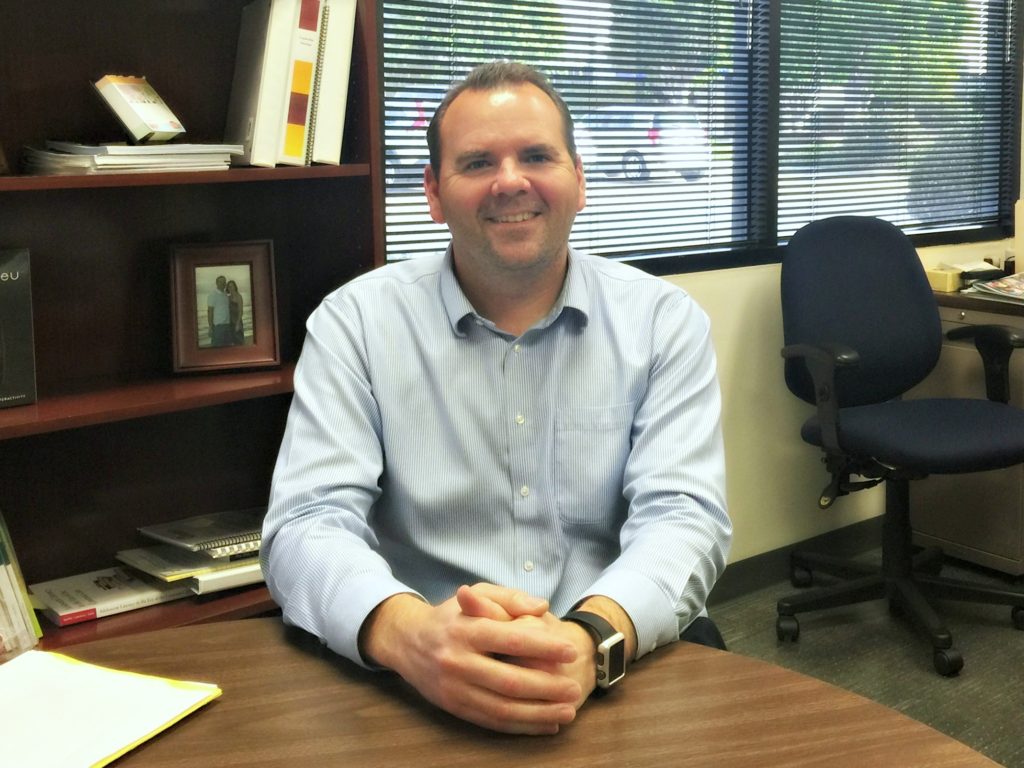Tom Turner’s title is an alphabet soup of abbreviations.
He’s OCDE’s director of STEM CTE, which is short for Science, Technology, Engineering and Math Career and Technical Education, and that means he’s responsible for supporting STEM instruction throughout the county. He also oversees the exploration of new educational technologies that make teaching more efficient and effective.
 It may seem like a lot of different pieces to manage, but Turner and his team are taking a holistic approach to STEM education, drawing on the interconnectedness of these subjects to make instruction more relevant. He’s even taken down some of the walls in the office to promote greater collaboration among his staff.
It may seem like a lot of different pieces to manage, but Turner and his team are taking a holistic approach to STEM education, drawing on the interconnectedness of these subjects to make instruction more relevant. He’s even taken down some of the walls in the office to promote greater collaboration among his staff.
“We have kind of flattened it all out,” he says, “because all of these areas come together, and that is what is being done in schools and the states.”
The OCDE Newsroom recently caught up with Turner to talk about his role, how schools are leveraging new technologies and what he envisions in the classroom of the future.
***
For starters, what role does OCDE play in supporting educational technology locally?
We meet regularly with district technology leaders and provide an opportunity for them to network and share strategies, as well as talk about some of the things that we know are coming up. We also offer services to individual districts. You may have a bigger district that’s rolling out devices but they really don’t know how best to do that, or you may have a small district that doesn’t yet have a vibrant technology department and needs help using an app on the iPad with first-graders. So we have the capacity to support them in those ways.
Educational technology seems to be evolving exponentially at this point. How do you keep up?
Ed tech used to be a thing where you would send teachers to get trained on a task like making PowerPoint presentations, and they would run to the computer lab and teach students. But it has definitely evolved. Now you have this device that’s in a student’s hand, like a tablet or smartphone, and we’re showing educators how to integrate that into what they are already doing in the classroom. Technology is engaging for students, and it has revolutionized education in a way that almost nothing else has. We’re constantly looking at how it impacts students and how to leverage innovative tools to better prepare them for college and career.
How are districts in Orange County using technology to support instruction?
Well, it varies by level, by comfort, by what your budget is. You may see some schools using technology in a makerspace way, meaning you’ll hear about 3-D printers in classrooms. Or you’ll see more robotics and coding.
Technology is being used to make things, to research and to collaborate. For example, if you and I are working together on a report about Egypt, we can sit here and work on the same presentation, and even at home I can work on a slide and you can be working on a slide. All of the four Cs (communication, collaboration, critical thinking and creativity) are coming into play.
What do you envision classrooms of the future will look like?
I think it’s going to be less of the traditional rows of students, and you won’t see as many textbooks sitting around anymore. Look at what Laguna Beach is doing with their classroom spaces, where there is hackable or customizable furniture. We are asking students to work together collaboratively, and the technology needs to keep up with that, whether it’s a Chromebook, an iPad or maybe even a wearable device.
It will also be seen in the display of student work. Whether it’s on a website, social media or somewhere else, parents want to see what their children are doing in the classroom.
We have been hearing a lot over the years about virtual reality devices, such as Oculus Rift. Are we likely to see anything like that used in the classroom?
Yes. Another product out there is Google Cardboard. The idea is to place students in a real-world setting, but you can’t always take a field trip down to the wetlands to see what that ecosystem looks like. Nowadays you can actually sign up on websites, and have a park ranger from somewhere out in the desert walk you through the ecosystem live, and they have a dish on top of their Jeep that they drive around the Mojave. That is a great thing for students. As technology advances, I think we will see more of that ability to actually walk through the desert from within their own classrooms.
Finally, what excites you about this type of work?
What is exciting is watching students use these new tools and seeing what they can do, which is so much more than what we did as students. Even when I was a teacher, when I had four or five computers in a room, we would visit the lab once a week and we would make movies, and it really got them to remember the content. That is what it is all about — these memorable experiences, and making students want to come to school and feel comfortable in the environment by creating a safe place. Technology has really done that, and it brings out more than what a book and a worksheet might do. For me that is really exciting, what it does for students and for teachers. To see them find something new, and the way it inspires their own professional practices, that is really exciting to me as well.
